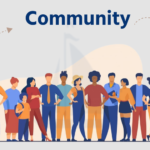
Introduction Solution-driven software
Solution-driven software means always trying to resolve issues and solve a specific problem.
In essence, software refers to programs that execute a certain function, however, the software solution has a wider meaning it could enclose not just the procedure code or program that’s written to achieve a specific task but also connect with other sections of software technology mechanism or organization.
Basic Concepts of Software
Enhancement and continuity: For instance, this involves ensuring that software remains functional and meets business needs and this comprises regular software improvement, upgrades, and combined response and development procedures.
Combination or Integration: Moreover the integration or consolidation with existing networks and technologies rather than exchange them makes sure that the software can be simply integrated into the existing information technology framework and decreases interference in the business.
Quality or standards: Software is designed with well-built importance on quality, as well as quality insurance testing procedures and this certifies that its software is secure, reliable, and competes with the needed performance and security levels.
User-based software: Solution-driven is planned with the user in mind and it assimilates the user experience basis to make sure that the software is inherent, easy to use, and meets the needs of the end users.
Problem-Solving: Ultimately address particular provocations or issues faced by individuals, occupations, or industries.Because its purpose is to supply practical solutions and efficient procedures to improve efficiency and productive capacity.
User Experience: Good software prefers user experience, and constructs it as easy to use, instinctive, and user-friendly and the interface and properties are planned to simplify specific tasks and enable users to navigate the software effortlessly.

Choosing the Right Solutions for Your Business:
There are some steps to assist you in making the right choice.
Research accessible options:
Firstly investigate dissimilar options in the marketplace and look for software that matches your business requirements and business excellence. However read reviews, compare features, and consider the reputation and track record of the software provider.
Recognize your business needs:
Recognize the particular challenges or problems you want the software to address. and deciding the key functionalities and features required to meet those needs.
Check for support and updates: Ensuring that the software provider offers reliable technical support and regular updates to address any issues or security vulnerabilities that may appear.
Consider cost and ROI:
Additionally, evaluate the pricing structure of the software and determine if it provides a good return on investment for your business. Considering factors such as licensing fees, implementation costs, and potential savings or revenue generation.
Seek suggestions and demos:
Talk to other businesses in your business or industry to get recommendations based on their experiences and request to get firsthand experience of how the software works.
Examples of different problem-solving Software
These are just a few examples, and there are many more solution-driven software options that turn on particular business needs.
⦁ Project management software
⦁ Enterprise Resource Planning (ERP) Software
⦁ Supply chain Management (SCM) Software
⦁ Customer Relationship Management (CRM) Software
⦁ Human Resource Management System (HRMS)
⦁ Business Intelligence (BI) Software
⦁ Point of Sale (POS) software
⦁ Marketing Automation software
⦁ Data Analytic software
⦁ Learning Management Software
⦁ Content Management Software
⦁ E-commerce platforms
⦁ Help Desk Software
Designing Solution-Driven software
⦁ Set goals: Clearly define what you want to attain with software. Make sure your goals align with user needs and business objectives.
⦁ Put the user first: Planning with the user in mind. Generate user persons and expeditions to perceive their behaviors and movements with the software.
⦁ Agile progress: Breaking down the development procedure into smaller duplications and
gather user feedback and make continuous improvements.
⦁ Solid backend framework: Building a reliable and secure backend system. So take care of data storage, backup, and security.
⦁ Testing and quality assurance: Thoroughly testing the software thoroughly for bugs and issues and perform user acceptance testing to ensure it meets user needs.
⦁ User training and support: Offering comprehensive documentation and ongoing support and helping users make the most of the software.
⦁ Continuous progress: Gathering user feedback and data to identify areas for enhancement. Additionally, Release updates based on user needs and market trends.
Understanding the need for solution-driven software
This software is all about finding practical answers to the problems we face and it’s like having a tool that helps us work smarter, not harder. By using this kind of software, we can streamline our tasks, save time, and be more efficient. It’s like having a personal assistant who takes care of all the nitty-gritty details we can focus on what really matters. Moreover, it aids in making better decisions by giving us insights and data analysis. So Driven software is all about creating tools and applications that directly address specific problems or needs.
It’s like having a tailor-made solution that fits your exact requirements and this variety of software focuses on distributing practical results and helping users attain their objectives. Then it can be used in various industries and sectors, from business management to healthcare to education and the key is that it’s planned to provide efficient and effective solutions to real-world challenges.
There are a few key points to understand the need for solution-driven software:
Identifying Challenges: Problem-solving solutions aim to address particular challenges or issues that people encounter in their daily lives or work.
Effectiveness and Efficiency: The primary purpose is to provide efficient and effective solutions to these problems. So it streamlines processes, automates tasks, and improves overall productivity.
Tailored Solution: The software is planned to meet specific needs and Developers analyze user feedback and main points to create customized solutions.
Conclusion:
In conclusion, Problem-solving software is like having a helpful intimate who’s always ready to assist you in solving issues. It’s planned to supply practical solutions to specific problems, making your life easier and more effective. Whether it’s robotic tasks, organizing data, or improving communication, this variety of software is customized to meet your requirements.







